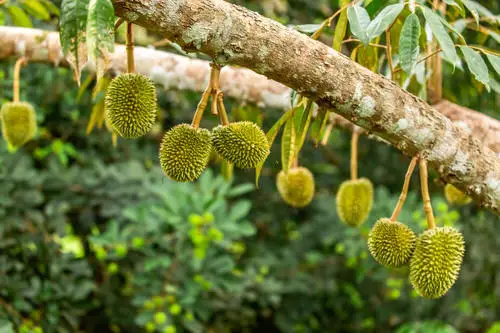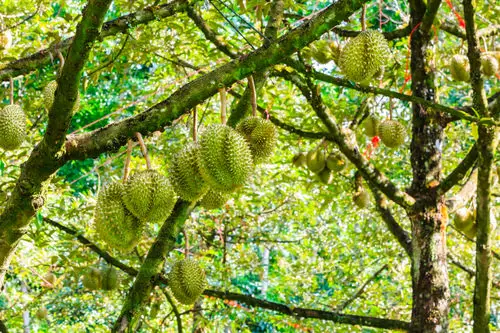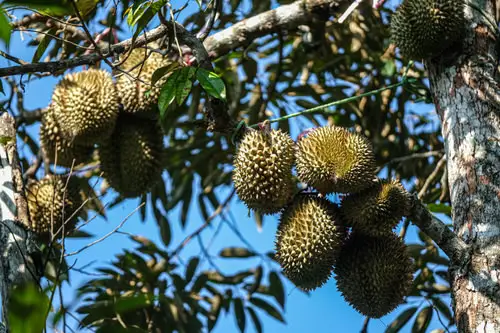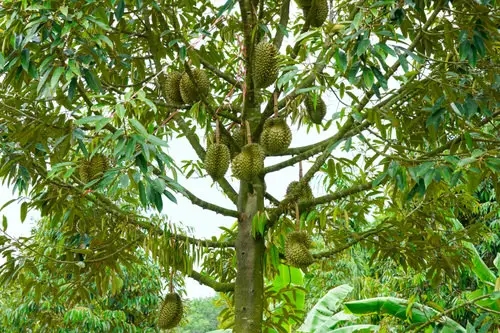Can you Grow Durian in California? If this question is knocking on your mind, we have got you covered in this informative article below!

Can You Grow Durian in California? is a question that many gardeners in the Golden State might ask, given the popularity and unique taste of this tropical fruit. Let’s explore the potential factors that will clear your doubts!
Explore Jackfruit vs. Durian vs. Breadfruit
Durian Plant Profile

Botanically known as Durio zibethinus, Durian is an evergreen plant with a short, upright trunk and dense open crown that spreads unruly with its rough, peeling branches. The oblong fruits are stout and woody with a greenish-yellow rind that bears a harsh, spiky texture and splits to creamy-white, yellowish, or orange flesh and seeds.
The plant is hardy to USDA zones 9-12 and is native to Borneo and Sumatra. Durian can be consumed fresh, frozen, or cooked in sauces and syrups. It is a rich source of potassium, magnesium, and Vitamin C.
Can you Grow Durian in California?
The simple answer is No, you cannot grow Durian in California. Durians are native to the equatorial tropics and need hot, humid climates to grow. However, according to reports, the climatic conditions of the state are unsuitable for the plant to grow well and produce fruits.
The fluctuating temperatures and relatively low humidity of California can hinder the growth and fruit production of durian trees. Furthermore, this tropical tree is highly susceptible to frost, which can occur in California during winter months, especially in inland areas.
Additionally, durian trees require a high amount of water and well-draining soil, which can be challenging to maintain in drier, drought-prone regions in California.
However, experienced gardeners in California may attempt to grow durian trees in controlled environments, such as greenhouses or indoor spaces with temperature and humidity regulations. However, do remember that mature durian trees can reach heights of up to 150 feet (45 meters) and can take anywhere from five to ten years before they begin producing fruit. So, it is not a practical idea to grow this tropical fruit in the Golden State.
Find the Best Lemon Varieties in California
Climate of California

Most parts of California experience a Mediterranean-like climate with warm, dry summers and wet, cool winters. The coastal regions are spared from extremes due to the moderating effect of the oceans.
The average temperature of the state hovers around 50 F or 10 C spiking up to 80 F or 26 C on the hottest days with an average rainfall of 770 mm of rainfall annually.
The mountainous regions of California, including the Sierra Nevada and the Cascade Range, experience colder temperatures, substantial snowfall, and significant precipitation during winter months.
The climate of California is also heavily influenced by weather patterns and phenomena, such as the El Nino-Southern Oscillation (ENSO), which can cause variations in precipitation and temperature. Additionally, the state is prone to periodic droughts, wildfires, and occasional heatwaves, which can have significant impacts on the environment and agricultural activities.
Look at the Best Wild Flowers of California
Where Can You Grow Durian?

This tropical fruit needs an average of 75-86 F or 24-30 C to fruit. It is not resistant to frost. Durian grows in humidity and requires a minimum of 75-80 %, with an average of 1600-4000 mm of rainfall annually.
Durian is found in the tropical and subtropical regions of South Tenasserim, Lower and Upper Burma, and some parts of peninsular Malaya. The southeastern part of India, Ceylon, and New Guinea. Some parts of the Southern Philippines are also suitable for growing Durians.
Malaysia and Thailand are the largest producers of this fruit due to their tropical-equatorial climates. While the plant is not suitable for growing in the countries of the New World.


